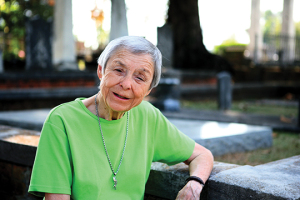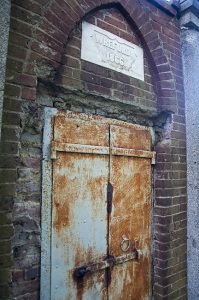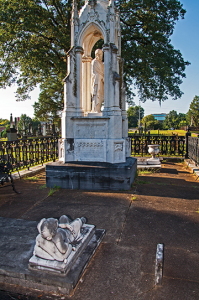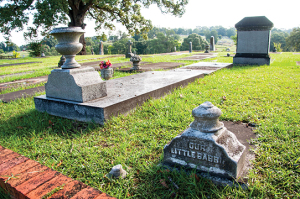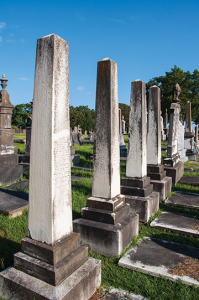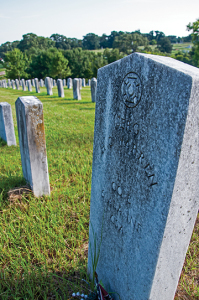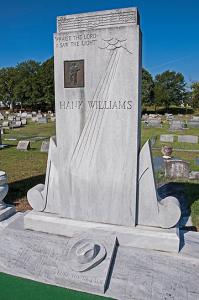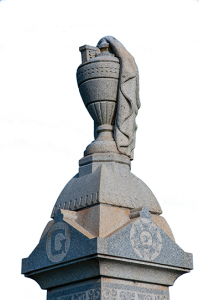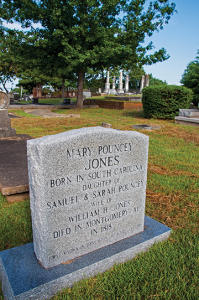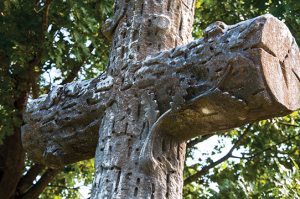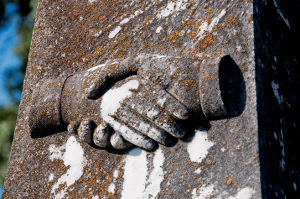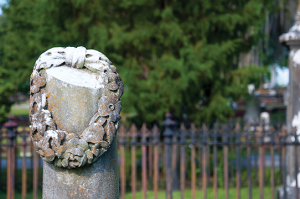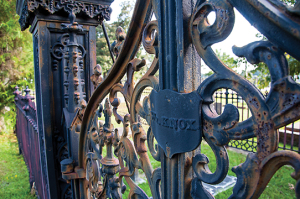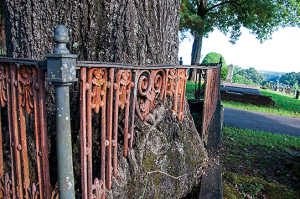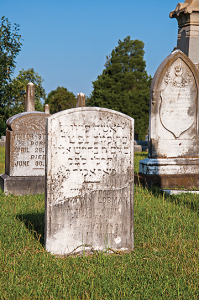Buried History: Oakwood Cemetery
Posted on October 4, 2014 by bob in Features
by Tom Ensey; photos by Bob Corley (except as noted)
Montgomery’s Oakwood Cemetery was once a gathering spot where those above ground went to visit those below. It’s a park-like place with its own neighborhoods of rich folks, not-so-rich folks, slaves, free blacks, Jews, Catholics and soldiers. However, Mary Ann Neeley, resident authority on the history of all things River Region, thinks of Oakwood not as a cemetery, but an open-air museum.
“Think about what a cemetery is for,” she said. “We have epitaphs, which give us information about the people there. That
makes it a history museum. We have art, and that makes it an art museum, with the statuary, the ornate fencing and the landscaping.”
The graveyard shift taking place here, she said, includes efforts to recreate the landscaping of the 1890s.
“The red cedars are growing particularly well,” she said. “They are getting big!”
Whether you’re a history buff or not, Oakwood is a cool place to visit, take pictures, admire the work of the masons and iron smiths who made the headstones and statues, and spend time with some of your neighbors who are no longer with us.
American author F. Scott Fitzgerald was a 2nd Lieutenant in the Army stationed at Camp Sheridan during the last days of World War I. He met and married local girl Zelda Sayre, who once wrote him a letter about trying to pry open the iron door to a mausoleum where a man was buried in a canoe.
She was describing Lot 3, Square 33, of Oakwood Cemetery where Samuel Pippin Wreford had a mausoleum built into the side of a hill near the railroad track. He was buried in a cast-iron casket shaped like a canoe. The door is welded shut now, and Wreford’s bones – and presumably the canoe – are long gone.
The oldest part of the cemetery is Scott’s Free Burying Ground, donated by city fathers John Scott and Andrew Dexter as a place where any resident could claim a plot to forever rest. The first documented burial was Mrs. William H. Jones, the daughter of Rev. Stephen Pouncey. She was the first white person buried in what is called the Old Cemetery. Only a corner of her headstone remains in the northeast corner of Banks Mausoleum.
Dexter’s wife Charlotte Morton Dexter is buried to the right of the entrance gate under a flat marker. Her son has a large marker next to her, an obelisk topped by either an acorn or an urn. It’s hard to tell. Acorns symbolized rebirth, because they grow into strong and everlasting oak trees, of which there are plenty in the graveyard. The biggest and oldest of these, near the top of the central hill, has completely engulfed an iron fence.
Also in the cemetery are two of the oldest known graves of slaves – “Jim, remembered for his virtue” and the nameless “Good and faithful servant.”
Perhaps the most distinctive graves in the cemetery are those of Mary and her Lambs, where Mary Walton Hill and her young children are buried. The imposing figure of Mary stands under a towering arch fashioned in Philadelphia. In 1983 vandals tied a rope around the statue’s neck, knocked the head off and skinned a knee. She has since been repaired.
According to Neeley, Mary Hill got sick and died right after her baby was born. Two of her children had already died and two more followed. Some said they died of typhoid, some said scarlet fever, “but it was probably just a bug,” said Neeley. They are all buried together.
“It’s a beautiful example of a mother looking over her children,” Neeley said, “as the mother of God looks over her children.”
Nearby, in the Wiley family plot, is a small marker inscribed “Our little Babby, Trusted and True” – the family dog.
There are two Jewish sections, the Land of Peace, established about 1850, and Eternal Rest, formed about 1885. In this section are four identical markers more than five feet tall memorializing four teenaged boys who drowned in late September, 1876.
Five boys, all cousins, had boated over to the peninsula, Neeley said, and on the way back were horsing around and tipped the boat over. One managed to swim to safety, the others died. The funeral was one of the biggest held up to that time; the editor of the Montgomery Advertiser wrote of seeing the procession pass his window, more than 60 wagons, buggies and carriages and many more people on foot.
“School didn’t start then until Oct. 1,” Neeley said. “They were high-spirited boys and this was probably their last fling before school started. It truly was their last fling.”
The “watery grave” is a decorative marker of 14-year-old John Schockler. It’s inscribed with the tale of how he ignored the advice of his two good friends and drowned in the Alabama River in 1855. The boy’s father was a stonemason, and is presumed to have fashioned the marker, carved to resemble a bed with a pillow. When viewed from a certain angle, the covers look like waves.
The Confederate cemetery contains the graves of soldiers wounded in battle and shipped by rail to one of four hospitals in Montgomery during the war. Those who died were buried here, many from the Battles of Shiloh and Atlanta. There’s a Union presence as well, graves of occupying soldiers who died here in the late
1860s after the Civil War.
The cemetery contains dozens of examples of funerary art, from weeping angels, to lambs, doves and cherubs on the graves of children, to broken trees, symbolizing lives cut short. Weeping willows, a popular symbol of mourning, adorn many of the headstones from the 19th century. The ironworks, some of which may have been manufactured locally, are ornate and beautifully wrought.
There are also great crosses wrapped with vines, carved of Sylacauga marble, polished obelisks that look blue in certain light.
Hank Williams and his wife, Audrey, are buried in the Oakwood Annex, with lyrics from his songs, a cowboy hat and a guitar carved into the marble. At midnight, you might even hear a midnight train whining low, and a lonesome whippoorwill.
Almost 200 years of Montgomery history is preserved in Oakwood Cemetery, unusual in the Deep South, with whites, blacks, Catholics, Protestants and Jews interred together, forever.











